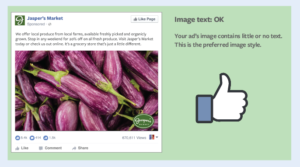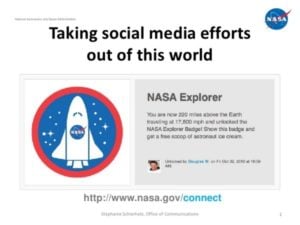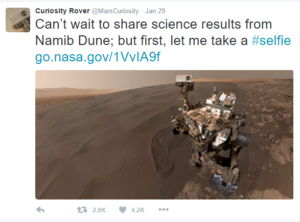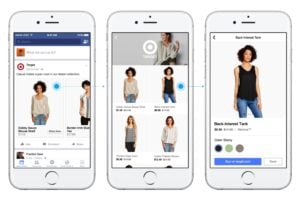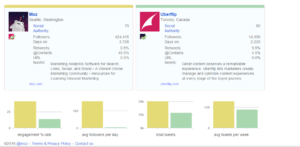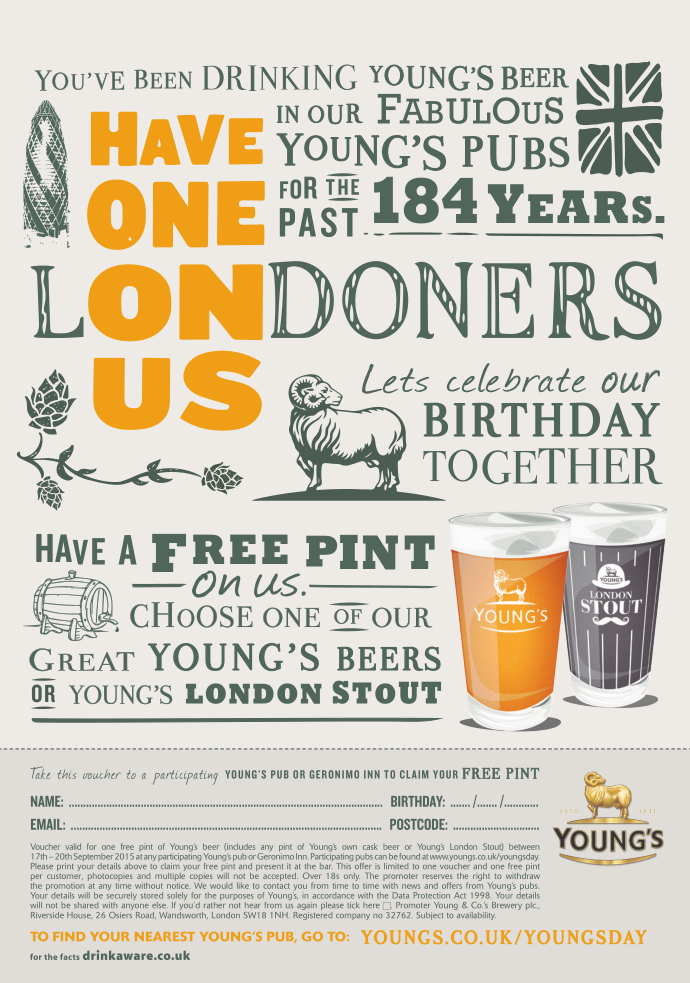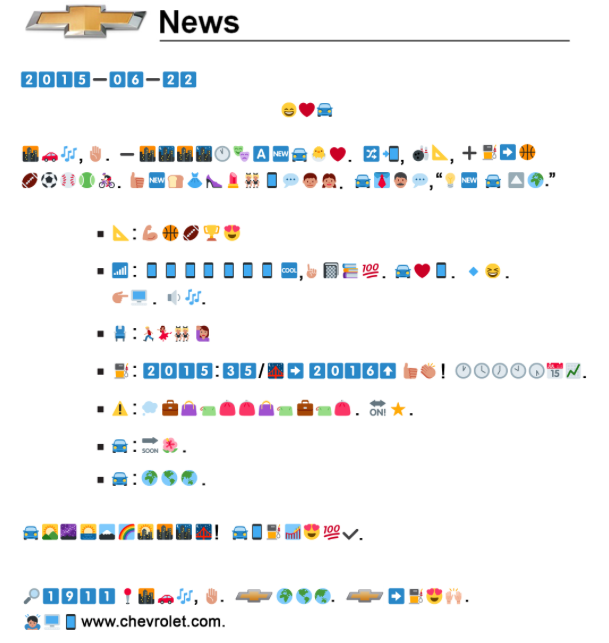Today I went to use the grid tool, which helped you check whether your image would be approved or not, however, I couldn’t find it. And this is when I discovered Facebook’s policies have changed… dun-dun-dun!
Now, images must have as little text as possible. It means that the more text these images have, the more the reach of the ad will be limited.
An email to Greg, our Facebook contact, confirmed this. He said:
The text policy has changed slightly in that your ads won’t be disapproved for having over 20% text anymore, instead the ad will be approved but if an ad has a lot of text in it then it will be penalized on the delivery front so the reach will be limited.
Going forward, I imagine it will help with relevancy, making ads look more streamlined within the news feed and less intrusive for users.
More info can be found here
Forty-seven years later, NASA is the most famous space agency in the world and is one of the most recognizable social media brands in the world. Indeed, when asked to mention a space agency, the name of NASA is the name that automatically crosses Western peoples’ minds. With 14.7m Twitter followers, and 9.2m followers on Instagram, there are few businesses that have such a great established social media presence as NASA. NASA even won the Shorties’ Sixth Annual Ceremony prize in the ‘Social Media’s Best Government’ category.
You’ve probably heard about the ‘Curiosity rover’, the NASA robot super star, tweeting selfies from Mars, making space exploration fun instead of a closed-doors club requiring two PhDs to make sense out of it.
As part of their communication strategy, astronauts have also been asked to contribute to social media content. In 2013, the cover of David Bowies’ “Space Oddity” by the astronaut Chris Hadfield aboard the Internation Space Station went viral and reached almost 31 million views on YouTube.
NASA’s presence on social media not only enables the space agency to inspire wide audiences but is also a clever way to increase its budget. Indeed, NASA is primarily financed by public funds and the agency is legally not allowed to engage in lobbying. Some therefore might argue that NASA’s popularity influences the American government to allocate more budget to NASA’s next exploration.
By making astronauts the new Superheroes and robot’s eco-friendly rescuers, Hollywood is also a key asset to NASA’s popularity, positively contributing to its brand image and communication, take the Oscar nominated film ‘The Martian’ for example.
NASA is a great example of an institutionalised company that successfully embraced social media in ways that are beneficial for educating and informing its audience whilst fostering the relevance to invest in space exploration.
Simply hover over the Like button (or, if you’re on mobile, press and hold) and the Reaction icons will pop up. There are four faces to choose from, one heart and one thumbs up – or you can download a ‘Reaction Pack’ and customise to your heart’s desire. The number of Reactions a post receives are separated out, so you can see exactly how people are reacting (rather than pressing the Like button for a myriad of different reasons because it was the only option available).
Right now, this looks like nothing more than a fun new feature. And maybe it is just that. But these Reactions could help inform future content, as we can see – as clearly as one can on social – the emotions and intent of the user, so we’ll know what posts do and don’t work going forward. And, because you don’t have to be an admin or a fan of a certain page to see its Reaction breakdown, we could potentially use this as a research tool for competitor analysis or content planning.
So whether you think Reactions will give us valuable, additional insight into the behaviour of our audience or not, emojis are still influencing the way we interact online in a major way.
Want to read more? Here are a few articles you should read:
Facebook Reactions: What Marketers Need to Know – Social Media Examiner (this is a bit dry, but very informative and clearly demonstrates how to use Reactions for different kinds of content)
Do brands need to care about Facebook Reactions? Absolutely not – The Drum (an interesting opinion piece, if not a teeny bit whiny)
Facebook Reactions: how to make the most of six emoji – The Verge (read if you need a laugh)
Read more about the rise of Emoji here.
When clicked on through a native Facebook ad in the newsfeed, the ad will take up the whole of a mobile screen and allow people to interact with it by scrolling horizontally, vertically or with the video. This full-page, immersive experience will allow for visually engaging stories using video, still images and text. Load times will be minimised with integrated calls to action, so the user experience will be instantaneous.
Creating the ad will be easy, as advertisers will have access basic self-service tool that requires no software or coding. Also, most of Facebook’s ads objectives, delivery, pricing and auction mechanics that are already in place will apply to the Canvas format
More exciting news; the Canvas format is also going to be released onto Instagram in the second half of this year!
Here at Tug we’ll be interested in testing out Canvas when creating paid social ads, and can’t wait to see what other engaging content is created with the tool!
Read more about putting creativity and social media together.
An element of the plan is also to introduce a personalised URL that businesses are able to share which will open a chat with the consumer. There is rumour as to whether this change will shift brands towards using Messenger as an alternative for more traditional customer service portals.
Facebook users will however breathe a sigh of relief when they hear that thankfully businesses will not be able to contact them without having had prior contact. The purpose is not to make Messenger an advertising portal for anyone who has simply ‘liked’ a business or brand.
However, finding influencers is not the only thing that Followerwonk will allow you to do. It is also a great tool for the following:
- Competitor Benchmarking
- Audience Profiling (age, gender, location)
- Content Discovery
The ‘Search Bios’- Feature
The ‘Search Bios’-feature allows you to look at Twitter users in more detail. In the below examples, I was looking for Twitter profiles of users that had an interest in cloud computing (click on image to enlarge):
The results that were returned to me showed me influencers that feature the term ‘cloud computing’ in their bios. This allows me to then approach the influencer with the view to collaborate together on this topic or provide them with some insightful data/statistics they might be able to use. It is all about finding users that are passionate about the topic you approach them for (click on image to enlarge):
The ‘Compare Users’-Feature
This feature is very useful for competitor benchmarking. We can for example compare one brand to another similar brand and then analyse their followership as well as potentially approach the users that engage with the competing brand in the space (click on image to enlarge):
As well as analysing Twitter followers in more detail, we can take a closer look at our competitors’ engagement rates to see if they are outperforming us on their social media channels. This will give valuable insights into what type of content competitors are hosting and why it is performing well.
The ‘Analyse’- Feature
The ‘Analyse’-feature looks at a lot of handy data such as:
- Most mentioned users
- Most mentioned domains
- Most important Tweets
- Users they follow
- Their followers in more detail
Conclusion
Followerwonk is available as a free and paid-for version. As a Moz user, you will be able to use the paid-for version as part of your subscription. While Followerwonk alone won’t be able to inform your content strategy, it will give you valuable insights into your audience, your competitors’ audience as well as some more detailed audience profiling. Many brands put a huge emphasis on Twitter behaviour and rightly so, particularly when social data from other social platforms like Instagram is not easily accessible like for example Twitter data. Informing your content strategy will allow you to target the right audience as well as go after the right influencers to share your content on their platforms.
This resolution is simple, easy to keep, won’t make you sweat in uncomfortable places or cost you a penny. So listen up, fellow marketers and human people of the world!
Here it is: RE-HUMANISE YOUR AUDIENCE.
‘But how?’ you ask, intrigued.
A good place to start would be to stop saying these words in particular:
CONSUMER
HACK
CONTENT
These words – when used in a marketing context – only generalise things that shouldn’t be generalised. Let’s go in more depth with each one.
CONSUMER
This concept is an odd construct, implying that human beings exist only to buy your product or somehow change into a different mode when they think about buying something. It’s essentially a trick. It can make what follows it sound more believable, because it’s dressed as a “professional” statement. By dehumanising it, the nonsense can seem logical.
Let’s look at this example:
‘Our consumer is someone who isn’t in the premium segment but is prepared to pay for a mid-market product.’
Who do you know who would want a ‘mid-market product’? That’s what I thought.
Substitute in the word ‘people’ and see what happens to the sentence:
‘Our people aren’t in the premium segment but are prepared to pay for a mid-market product.’
Sounds much, much worse, and is frankly a load of horseshit. Your people don’t want mid-anything. They want the best that they can have.
HACK
This word has been so overused that it’s completely lost all meaning. Here are just a few of the many dictionary definitions of the word ‘hack’:
to cut or sever with repeated irregular or unskilful blows
to manage successfully
a short, dry cough
to gain access to a computer illegally
a usually creative solution to a computer hardware or programming problem or limitation
However, in this day and age, the word ‘hack’ (usually following the word ‘life’) has been tacked on to the titles of articles, videos, illustrated guides and blog posts to signify anything designed to be vaguely helpful, like this:
‘100 Life Hacks that Make Life Easier.’ (This is an actual article, by the way).
What does this even mean? Are these step-by-step instructions? Tips? General advice, Pinterest-style (~if s/he can’t handle you at your worst, s/he doesn’t deserve you at your best~)? How will your HUMAN audience find this useful or interesting?
This is the kind of article that ‘consumers’ read, not people. Let’s agree to stop creating them.
CONTENT
Again, this is such a broad term that it’s virtually meaningless. We’re always banging on about ‘creating great content,’ but WHAT DOES THAT ACTUALLY MEAN?
‘Content’ is for ‘consumers’, not human readers/listeners/viewers. In order to humanise this concept, we need to start defining what we make in specifics.
Instead of saying, ‘I need to make some good content this month,’ say exactly what you mean: ‘I need to create an awesome short animated video’ or ‘I need to write and record a satirical podcast’ or ‘I need to make an infographic using this data set.’
If you stop using the word ‘content’ to refer to anything you make, you will focus on the medium more, which will inherently remind you that you’re speaking to other people, which is the most important thing.
So, this year, if you resolve to do one thing, let it be this: stop saying ‘consumer,’ ‘hack,’ and ‘content,’ and start thinking in terms of actual people.
Paid media campaigns conducted through Facebook allow for users to be targeted based on their interests as ascertained through their behaviour within the platform. This allowed us to structure and carry out a tightly targeted campaign, serving ads that both functioned as offer redemption mediums as well as page like accumulators to an audience we knew would want to hear what we had to say – have one on us! We targeted users who had displayed a proven interest in pub culture and real ale, with the goal of linking the online campaign directly to the pub culture, and drove ale fans of all ages into their local Young’s pub for the duration of the campaign.
The campaign was a great success, with the Young’s Facebook community nearly doubling in size in less than a week. We learned a lot about our new audience, and made some serious headway in connecting the brand to a younger generation of ale drinkers and pub goers.
Despite the campaign now being over I’d highly recommend any of the beers that Young’s has to offer. Starting in November, and for a limited time only, you can even get yourself a pint of the famed Christmas Ale!
It’s that time of year again where thousands of people descend on central London for Social Media Week. I made a personal stand not to attend this year’s events as I wanted to track the whole thing via… well… social media.
I began pulling data on certain hashtags used throughout the event around one week ago. So, rather than fighting my way through crowds of skinny jeans and Ray Bans, my skinny jeans, Ray Bans and I can consume this content from the comfort of my own home… or office.
Sessions began on Tuesday (15th September) and #SMWLDN has already seen over 12,000 Tweets dedicated to it. That’s a pretty decent amount of Tweets being published right? Let’s bear in mind that these 12,000 Tweets were produced by 3,193 people, so as expected, we’re seeing the same people Tweet multiple times with only 67% coming from mobile. This is in part due to journalists publishing content from laptops.
Through my data I’m able to see what the big talking points are. That’s pretty handy given the fact that every year I sacrifice one session to go to another only to find out that the one I missed was the greatest and most insightful hour in the history of humanity.
So, what are people chatting about?
Pinterest. Yep, you heard me, Pinterest. It appears a session given by Zoe Pearson (@Convo_Pieces) got the fingers tapping as the audience rushed to Tweet that Pinterest now receives 80% of visitors through mobile. As a slight caveat, mobile becomes a bigger part of SMWLDN every year. It’s not to be overlooked though is it? It’s a big point. If mobile consumption continue to rise, that totally effects the execution of our strategies from a format, content, search and media point of view. Zoe also told us that two thirds of pins actually come from brands.
It’s always interesting to see which platforms and publishers get tongues wagging at social media events. With thousands of social professionals walking through the door aiming to find that latest piece of insight to take back into their office, these conferences can actually help to shape the future of the industry.
To that point, it’s interesting to see that Social Media Week’s opening day saw over 600 people talking about Buzzfeed. Buzzfeed’s Director of Brand Partnership’s, Jonathan Davies, is giving a master class (as I type this very article) about how to speak the language of emojis. I know right. I hate to say it but it’s quite a timely talk. Over the past few months, brands have had to make a decision whether or not to include emojis in their tone of voice.
“All the kids are using them”
“Are we ‘cool’ enough to do that”?
“Why would we ever need to Tweet an Aubergine”?
Taking it to its upper limit, Chevrolet’s media release for their new model, ‘the Cruz’ was ‘written’ entirely in emojis. Decipher this one kids:
Nope, me neither.
Looking through more data led me down a fairly strange route. One of the most commonly used words was ‘science’. Not exactly the first thing you associate with the skinny jean brigade. However, looking into this, you discover that (in my opinion) for the first time during SMWLDN brands are getting heavily involved. Particularly, the National Gallery.
We know from previous events hosted by Twitter they have a strong relationship with not just the National Gallery, but a good number of UK museums. Ultimately, this was born out of there Museum Week initiative which encourages these attractions to give a behind the scenes glimpse into their activity and exhibitions through Twitter. This is pretty refreshing. When agencies and freelancers dominate the conversation, you usually end up with very opinionated content surrounding the event, but seeing brands leveraging the activity is great to see.
Finally, two of the most commonly Tweeted words during the opening day of Social Media Week are ‘people’ and ‘Periscope’. I couldn’t have put it better myself; two big areas in social media at the moment.
People. I’m not going to bore you with the standard gubbins about the importance of people on social, but what I will say is there needs to be a bigger focus on ‘the person’. People is a collective term and for far too long, brands have been focusing on people / audience as a collective term rather than the individuals that make up that group. We’ve even began trying to plot the total audience of our clients on a map to begin to see the location of individuals across different geographical segments; how do users in the North differ form those in the South? Do their passion points change? Different users engage with content and messaging in different ways. You can’t win them all every time, but you can continually evaluate available data to assess what worked well, where and with who.
Periscope. Rather than focusing singularly on the tool, the concept of Periscope is an interesting one.; one which I feel is a major area at the moment. There is an increasing demand for content on the move; content that can be consumed at any time with little effort on the behalf of the user – immediately accessible content. That’s exactly what these tools are providing, instant content. For years, we’ve spent hours building content calendars and planning creative, but are we on the verge of moving towards the mindset of a publication like Buzzfeed or The Economist’s Espresso App? Providing users with relevant, real-time content at mass volume?

